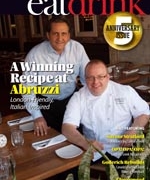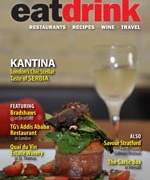Putting It All On the Table
Adam Gopnik is an American who has made a career of writing essays about France, mostly for The New Yorker and in his best-selling memoir, Paris to the Moon. His latest book, The Table Comes First: Family, France, and the Meaning of Food, tackles one of France’s most endearing subjects – its cuisine. Gopnik introduces his topic by saying, “More people talk about food now – why they eat what they eat and what you ought to eat, too – than have ever done before.” And he’s not referring to dieters going on about calorie counts and trans fat content. These are the gourmets, the foodies, the chefs, the locavores, and the cookbook authors that have cropped up since food has taken on such a central role in cultural media. Much thanks can be given to Food Network for making food centre stage alongside the super-star deified chefs that sing its praises, giving rise to the foodie culture that cares about taste and quality above all else, but Gopnik wants to learn if we really know the true meaning of our food. Gopnik’s approach to food is highly cerebral and scholarly, referencing philosophers and food writers, and delving into numerous aspects of eating not always contemplated during our daily routines. The concept of taste, he writes, is very personal: “If you don’t like Brussels sprouts, I can argue you into trying them, but I can’t argue you into liking them.” But it is still an argument worth having, he insists, to stick up for our tastes, to prove that we like food so passionately to fight for it being consumed by the unconverted. Brussels sprouts seem to be a likely candidate for this argument – you either love them or hate them (taste is capable of taking on these strong feelings) and converting a non-lover of Brussels sprouts is a difficult task, because “the chef’s life is a long struggle with the reality that tastes differ, and tastes change. The mutability of taste is a truth chefs live with every night.”
Recipes are another personal touch that represents all that is good about home cooking. Even though personal, they are rarely our own because they come from a cookbook or handed down from relatives; someone else has invented them before you until you add your own hand to making them. “We recognize the concept of sweat equity in recipe writing: if you have laboured nightly over a stove in a restaurant kitchen cooking the thing, then you can write it down, even if its origins lie ultimately not in your own mind but in someone else’s cooking.” Recipes are only starting points, each one different, to create your own narrative in the kitchen, and the real recipe, Gopnik writes, “is the totality of the activity, the real work. The recipe is to spend your life cooking.” Cookbooks can be encyclopaedic anthologies of recipes, grammatical guides to the language of cooking, and poetic treatises to flavours.
Another age-old question is whether to dine at home or at restaurant, to lovingly prepare a meal for your family from your treasure trove of favourite recipes, or to be treated like a guest of honour by being served a chef‘s creations. Gopnik traces the origins of restaurants to his beloved France, an 18th Century invention “where the idea of eclectic eating in big cities began” in Paris, of course, in the years straddling the French Revolution, most notably in the Palais Royal building across from the Louvre. “If the restaurant is not the most original of modern instances and institutions, it is surely the most tenacious. It is the primal scene of modern life. Most modern urban people mark their lives by their moments in cafes and restaurants.” Opening with wine or spirits, ending with coffee or tea, and eating several courses in between, Paris gave us the first restaurant “scene” – the buzz around the food being talked and written about by critics and gastronomic journalists was just as important as the food itself to get the word out there that a culinary revolution was underway. The whole notion of food writing (his own and that of many others) plays a central role throughout Gopnik’s string of essays, as it has been responsible for turning a creative and critical eye to a daily ritual that doesn’t necessarily need to be critiqued – “the small ambitions of the greedy eater as though they were big and noble, spoofing the idea of the heroic while raising the minor subject to at least temporary greatness.” Gopnik plays with language to deliver his own philosophies on eating: “We are what we eat? Probably closer to the truth to say that we eat what we are: the total self we bring to the table shapes the way we choose, and even how we chew. Our morals and our manners together drive our molars.”
Modernism has modified menus since those first restaurants and Gopnik takes a sweet trip through the world of desserts to see how they have been altered over the years. His most eye-opening experiences being with techno-cookery, also known as molecular gastronomy, creating things like “cucumber foam and powdered octopus” and Parmesan cheese ice cream. Chefs take creativity and invention into the realm of the scientist. And desserts, too, have been touched by this level of experimentation, becoming less sweet and mixed with more savoury elements, being subjected to the razzle-dazzle of kitchen technologies, like liquid nitrogen.
Following in the book’s overall format of essays about the subjects of France, family, and food, throughout the book, Gopnik has inserted snippets passed off as e-mails, in which he engages in a strange correspondence with dead cookbook author, Elizabeth Pennell, as a way to channel his culinary talents with a kindred spirit. He has high opinions of Miss Pennell (I dare say a culinary crush) and sees her as “the first to see the cookbook as a literary form – a thing worth saving and collecting, analyzing and writing for its own sweet or savoury sake.” He calls her “the rare kind of food writer who makes you digress, turn from analytical scrutiny to ardent fantasy”; Gopnik’s own style takes these types of digressions with some unusual twists and turns as he tries to commune with this dead cookbook author, one discourse being a comparison between rice pudding and the guitar playing of Keith Richards. How does this idea even form into a coherent discussion, you may ask? In a way only a gifted essayist like Gopnik can realize.
Gopnik tackles trendy topics in a chapter entitled “Meat or Vegetables?” He is introduced to whole animal eating rather than “the absurdity of our usual meat-eating, which clings to a few square feet of animal muscle near the skeleton.” Innards, ox tongue, tripe, spleen, brains, suckling piglet, kidneys, hearts, pig tails, bone marrow, hooves – these are specialities of Fergus Henderson’s restaurant in London, England, who “has become famous for his devotion to the odd bits of ordinary animals.” He doesn’t shy away from many animals, he’s even served squirrel in his restaurant, not without controversy. It is extreme haute cuisine with animal protein. On the opposite end, Gopnik asks the question: “Can a plate of vegetables really be enough to support a whole high style of fancy food?” Appropriately enough, he finds Chef Alain Passard in Paris who charges hundreds of dollars for a lunch that serves the freshest of vegetables from his own closely-watched garden in his unique cuisine vegetale. Both sides of the argument are addressed by Gopnik, not finding absolute answers, but finding that “real morality is neither that of evangelical vegans nor beautiful beast-eaters but simply that of the extreme case taken seriously.”
In the chapter titled “Near or Far?”, he conducts an experiment in localism, eating only food grown and raised in his New York neighbourhood, including foraging for edible vegetation within Central Park. (When he is not living in France, Gopnik resides in New York, and the regional research would be more fruitful in his French abode, but one must try in all circumstances to prove the efficacy of localism.) “We live in a food world where everything is possible,” Gopnik writes, but that doesn’t necessarily make it the right world, he continues, because “where everything is possible, little registers. To return to a world of limited choices – these Brooklyn eggplants, this Staten Island pepper – was to once again force the flower of invention, to make the cook, even one of limited powers, think again, act more resourcefully, invent rather than imitate.” Even with the green argument aside, localism is more of a stimulant for a chef because of its narrowness, rather than the overwhelming swathe of global food offerings. Gopnik shares that food’s importance comes from taste. There are arguments out there that food shipped from Africa may actually have less of a carbon footprint than those grown closer to home, but we choose the more local ingredients because they taste better, even with economic reasons aside.
Gopnik reminds us that people rarely give up food willingly (there’s a reason diets are notoriously difficult to stick to). The book’s ultimate message is that food is important, but it is the family and friends that gather for it around the table that matter more. Or as he says, “What if the truth was that we could take a single green pill that would give us all the nutrition we need and help sustain the planet at the same time? Would we gladly give up dinner in order to take it? This idea isn’t a joke or even a far-fetched thought experiment: the best evidence of the moment is that an extremely low-calorie diet is by far the best life-extender we know. How many of us take it up? Not many; the loss in the meaning of the table is too great.” Because ultimately for Gopnik, “The table comes first in the sense that its drama – the people who gather at it, the conversation that flows across it, and the pain and romance that happen around it – is more essential to our real lives, and also to the real life of food in the world, than any number of arguments about where the zucchini came from, and how far it had to travel before it got here.”










